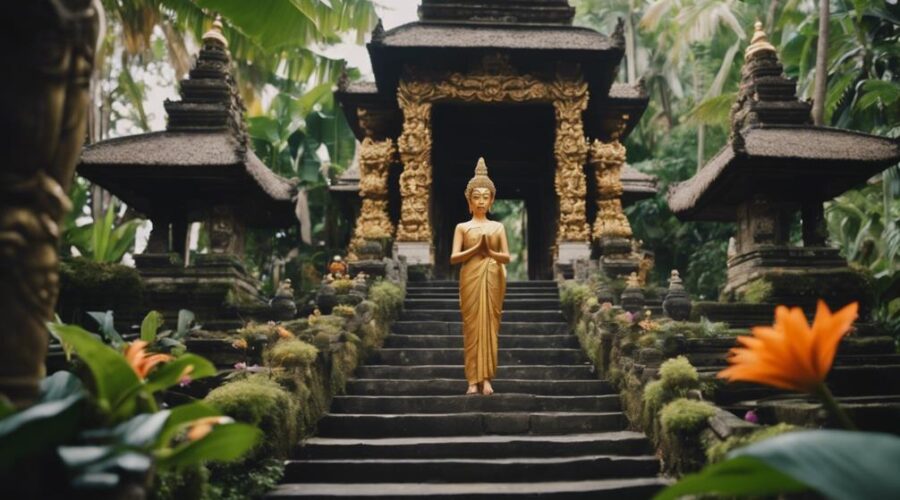Are Balinese Buddhist?
So, you've finally discovered that Bali isn't just about surfing and Instagrammable beaches, but a land with a rich tapestry of religious beliefs?
It isn't as simple as labeling Balinese people as Buddhists. Yes, Buddhism has a history in Bali, but it's not the dominant religion. The majority of Balinese adhere to a unique form of Hinduism, but that's not the whole picture either.
Intriguing, isn't it? How about we unpack this complex religious landscape, as it's bound to challenge your assumptions and broaden your understanding of this fascinating island?
Key Takeaways
- Balinese culture reflects a unique blend of Hinduism and Buddhism, with both religions significantly influencing the spiritual landscape.
- Despite Hinduism's dominant presence, Buddhist teachings, practices, and iconography are prevalent in Bali.
- Balinese monks lead lives combining Hindu and Buddhist practices, fostering a harmonious religious coexistence.
- While not exclusively Buddhist, Balinese culture deeply honors Buddhism's transformative power, viewing it as a life philosophy.
Understanding Balinese Culture
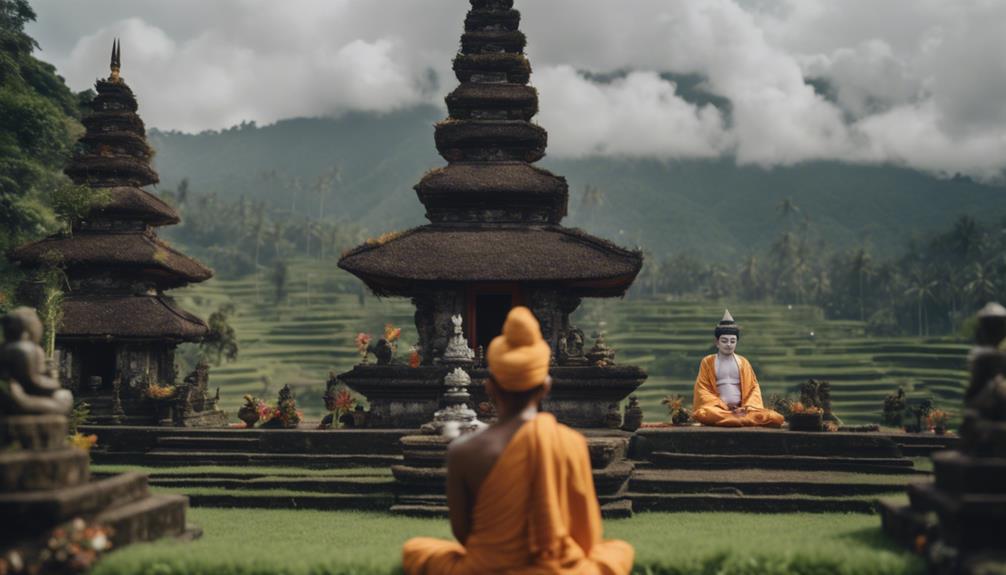
To truly grasp the unique nuances of Balinese Buddhism, it's imperative to first immerse yourself in the rich tapestry of Balinese culture, a vibrant amalgamation of tradition, spirituality, and artistry. Balinese architecture, an artistic marvel, is a key component in understanding its rich culture. You'll notice the intricate carvings and unique designs that showcase the Balinese's unyielding devotion to their faith. Temples, built with a meticulous eye for detail, are architectural masterpieces that reflect narratives of the divine.
Traditional clothing, too, plays a significant role. It's not merely an expression of fashion but also an embodiment of their deep-rooted spirituality. The crisp white cloth worn by men and women alike is more than a visual delight; it's a symbol of purity and their commitment to religious rites.
Additionally, the intricate patterns and vivid colours of their attire are a sign of the Balinese's flair for artistry and their innovative approach to tradition.
Fundamentally, the Balinese culture, with its stunning architecture and traditional clothing, gives you a profound insight into Balinese Buddhism. It's not just a religion but a life philosophy deeply woven into the fabric of their lives.
Brief History of Religion in Bali
You'll find that Bali's religious history is multi-layered, beginning with pre-Hinduism beliefs that shaped the island's cultural foundations.
Then, as we move forward in time, the Hindu-Buddhist era deeply influenced the spiritual landscape, changing the course of religious practices on the island.
These historical periods provide context to understand the complex tapestry of faith in Bali today.
Pre-Hinduism Beliefs in Bali
Before the advent of Hinduism, the inhabitants of Bali held a complex tapestry of beliefs, grounded in animism and ancestor worship. This intricate system was shaped notably by animistic traditions and shamanistic influences.
To help you comprehend this, let's break it down into three integral components:
- Animism: This was the core belief that every object, place, and creature has a spiritual essence. It encouraged a deep respect for nature and its elements.
- Ancestor Worship: The Balinese held a profound reverence for their ancestors, believing they influenced their daily lives and could offer guidance or protection.
- Shamanism: Shamans served as intermediaries between the natural world and the spiritual domain, performing rituals to ensure harmony and balance.
This pre-Hinduism period laid the foundation for Bali's unique spiritual landscape.
Hindu-Buddhist Era Influence
As the waves of Hinduism and Buddhism swept across Indonesia around the first century AD, they greatly reshaped Bali's spiritual landscape. This era's influence is palpable in today's Balinese philosophy and Buddhist architecture.
You can observe a fusion of both Hindu and Buddhist elements in the temples, monuments, and rituals. The intricate designs and symbolic motifs in Buddhist architecture embody the spiritual journey towards enlightenment, while the Balinese philosophy centers on harmony, respect, and balance between humans, God, and nature.
This Hindu-Buddhist era not only revolutionized the religious practices but also left an enduring imprint on Balinese culture, arts, and aesthetics. It's a sign of Bali's innovative adaptation of foreign influences, preserving its unique identity.
Dominant Religions in Bali
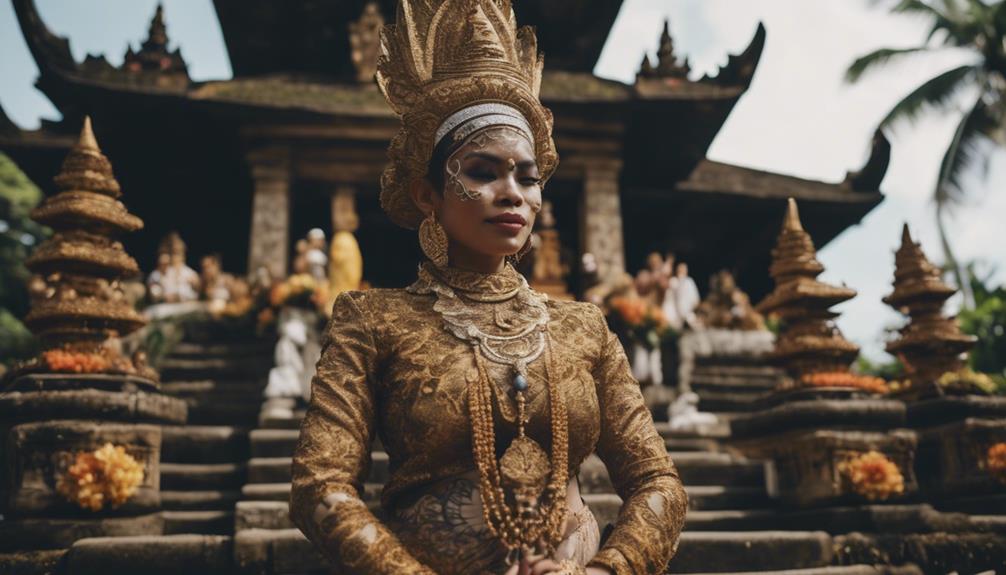
Delving into the dominant religions in Bali, it's apparent that Hinduism holds sway, despite the common misconception that Buddhism reigns supreme. This island paradise is a unique tapestry of faiths, and it's integral that we unravel this complexity, to gain a thorough understanding of Bali's religious landscape.
- Bali's Christianity: It may surprise you, but Christianity has a noticeable presence in Bali. Although its followers comprise a small percentage of the population, their impact is substantial. The Protestant Church in Bali, reflective of Indonesia's Dutch colonial past, and the Catholic Church, are two significant institutions. They've contributed to the island's education, healthcare, and social services.
- Islamic Presence in Bali: The second largest religion in Bali, Islam has a significant influence, especially in the northern and western parts of the island. The Arab traders introduced Islam to Indonesia, and it gradually found its way to Bali.
- Buddhism in Bali: While not as dominant as Hinduism, Buddhism has a peaceful coexistence with other religions. The Buddhist temples, known as Viharas, are often found adjacent to Hindu temples, exemplifying Bali's unique interfaith harmony.
In a word, Bali's religious tapestry is intricate, and understanding this can offer a fresh perspective into its rich cultural ethos.
Influence of Hinduism on Bali
As you turn your attention towards the influence of Hinduism on Bali, consider the historical impact this religion has had on the island.
Reflect on the unique blend of Hindu and Buddhist elements that shape Balinese culture.
Look closely at the rituals and ceremonies, as they reveal the depth of Hinduism's influence on Balinese daily life.
Hinduism's Historical Impact
Examining the historical impact of Hinduism on Bali, you'll find it has deeply intertwined with the local culture, shaping the island's traditions, beliefs, and societal norms. Hinduism's global spread reached Bali around 1st century AD, introducing profound changes.
- Impact on Artistry: Hinduism influenced Balinese arts, inspiring intricate sculptures and temple architecture.
- Establishment of Castes: Hinduism introduced the caste system, deeply influencing Bali's societal structure.
- Cultural and Religious Practices: Hindu rituals, ceremonies, and festivals became an integral part of Balinese lifestyle.
Hinduism's influence proved transformative, yet Bali retained its unique identity, demonstrating cultural resilience. Therefore, the impact of Hinduism on Bali isn't merely historical but forms an ongoing process of cultural synthesis and innovation.
Balinese Hindu-Buddhist Blend
While Hinduism's imprint on Bali is undeniable, you'll also find a fascinating blend of Buddhism woven into the island's religious tapestry, creating a unique Balinese Hindu-Buddhist fusion. Predominantly Hindu, Bali also embraces Buddhist teachings, shaping a vibrant spiritual identity.
Buddhist sculptures, often seen in temples and sacred spaces, reflect this synergy. These are not mere aesthetic additions, but profound symbols of the island's complex religious heritage.
To truly appreciate this blending, consider the table below:
| Aspect | Hindu Influence | Buddhist Influence |
|---|---|---|
| Art | Hindu deities | Buddhist sculptures |
| Teachings | Vedas and Puranas | Buddhist teachings |
| Spirituality | Dharma and Karma | Enlightenment and Nirvana |
In Bali, you'll discover that Hinduism and Buddhism don't exist in isolation. Instead, they interweave, creating a rich tapestry of faith and tradition.
Rituals and Ceremonies
Delving into the world of rituals and ceremonies, you'll find Hinduism's profound influence shaping Bali's religious practices and traditions. This blend not only shapes the spiritual life but also infuses the cultural fabric with distinct elements of Hindu mythology, Buddhist Iconography, and the austere Monastic Life.
- Buddhist Iconography: Bali's temples brim with statues of Buddha, Bodhisattvas, and Hindu gods, illustrating a unique co-existence of both religions.
- Ritual Practices: You'll witness ceremonies where monks chant mantras in Pali (a language associated with Theravada Buddhism), while offerings are made to Hindu deities.
- Monastic Life: The local monks live a life that combines elements of both Hindu and Buddhist monastic practices, reflecting a truly syncretic religious life.
This fusion has crafted a unique spiritual landscape, making Bali a fascinating study of religious blending.
Role of Buddhism in Balinese Life
In Balinese society, you'll find that Buddhism plays a significant role, shaping many aspects of daily life, from rituals and ceremonies to the philosophical underpinnings of their cultural practices. You'll notice the influence of Buddhist Monasticism, where monks lead lives of simplicity and spirituality, serving as guides and mentors to the community. They live by a code that encourages detachment from materialism, fostering a sense of humility and gratitude.
The Zen influence is also prominent in Bali, manifesting itself in the way people approach life and its challenges. Unlike other forms of Buddhism, Zen focuses on meditation and self-contemplation, promoting a state of mindfulness and self-awareness. This deeply ingrained Zen philosophy encourages Balinese people to live in the moment, accepting life as it comes with a calm and serene disposition.
Furthermore, Buddhist teachings also shape the social and moral fabric of Balinese society. Values such as compassion, tolerance, and non-violence are important cornerstones, influencing how individuals interact within their community and the wider world.
Hence, Buddhism in Bali isn't merely a religion, it's a lifestyle – a deeply embedded system of beliefs and practices that shapes their worldview, guiding every step along their life's journey.
Balinese Religious Practices and Rituals
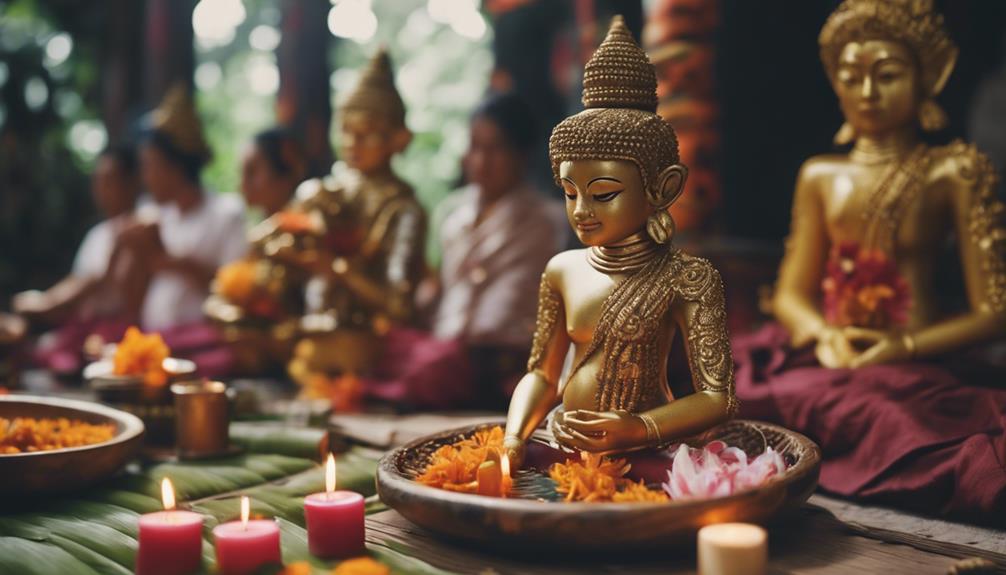
You'll find the complexity of Balinese rituals quite fascinating, especially when considering the influence of Buddhism.
Recognize the unique worship practices that distinguish Balinese Buddhism from other forms.
This distinctiveness is a proof of the rich cultural interweaving that characterizes Balinese religious traditions.
Balinese Rituals Complexity
Understanding Balinese rituals' complexity requires an in-depth look at the intricate practices and ceremonies that form the heart of their religious devotion. You'll notice a remarkable ritual significance, deeply entrenched in the cultural fabric of the island, with each event serving a distinct purpose. Symbolic elements are interwoven in these rituals, adding layers of meaning that connect the physical world to the spiritual.
- Nyepi (Day of Silence), marks a day of total silence, fasting and meditation.
- Galungan, a Balinese holiday celebrating the victory of dharma over adharma, involves an array of symbolic rituals.
- Odalan, a temple anniversary, is an elaborate ceremony with dances, offerings, and prayers.
Each ritual is a complex orchestra of tradition, religion, and culture, providing a mesmerizing insight into the Balinese way of life.
Influence of Buddhism
While the aforementioned rituals exemplify the depth of Balinese Hindu practices, it's worth noting the significant impact Buddhism has had on these religious ceremonies. Buddhist iconography, for instance, is prevalent in the Balinese temples and sacred sites. These visual symbols and images, such as the depiction of Buddha and the Bodhisattvas, speak to the deep intertwining of Hinduism and Buddhism in Balinese culture.
Moreover, meditation practices, a cornerstone of Buddhism, have heavily influenced the way Balinese Hindus connect with the divine. The incorporation of mindfulness and tranquility in their worship illuminates Buddhism's role in shaping their spiritual journey. Despite being mainly Hindu, the Balinese religious landscape reflects a fascinating fusion of beliefs, honoring the transformative power of Buddhism.
Unique Worship Practices
In exploring the intricate tapestry of Balinese religious practices, one can't help but notice an array of unique worship rituals that beautifully illustrate the island's rich spiritual heritage. You'll observe a blend of Buddhist iconography interwoven with indigenous beliefs, creating a fascinating spiritual fusion.
- Pura Besakih: Known as the 'Mother Temple', it's a remarkable display of Balinese devotion, with Buddhist influences evident in its architecture and ceremonies.
- Nyepi Day: This 'Day of Silence' is an intriguing blend of monastic traditions and local customs, offering a unique perspective on Balinese spirituality.
- Tri Hita Karana: This philosophical principle guides daily life and underpins all religious rituals, reflecting the Buddhist concept of interconnectedness.
These practices demonstrate a creative and innovative approach to spirituality that's uniquely Balinese.
The Concept of Tri Hita Karana

Often, you'll find Balinese Buddhism deeply intertwined with the concept of Tri Hita Karana, a fundamental philosophy that advocates for harmony with the divine, nature, and humans. This philosophy permeates all aspects of Balinese life, influencing their environmental philosophy and even Balinese architecture.
Regarding environmental philosophy, Tri Hita Karana promotes a deep respect for nature, a concept integral to Balinese Buddhism. Balinese people believe living in unity with the natural world, ensuring their actions don't disrupt the environmental balance. It's an innovative philosophy that encourages sustainable practices and a holistic approach to eco-conscious living.
Concerning Balinese architecture, you'll find Tri Hita Karana's influence manifesting in the design of buildings. Balinese structures aren't just aesthetically pleasing; they're designed with the intention of fostering harmony between humans, nature, and the divine. This architectural approach results in buildings that seamlessly blend into their surroundings, creating a delicate balance between the built environment and the natural world.
Essentially, Tri Hita Karana is more than a philosophy; it's a way of life that merges religious belief, environmental stewardship, and architectural design in a harmonious blend, making Balinese Buddhism unique and fascinating.
Balinese Temples and Shrines
Stepping into a Balinese temple or shrine, you'll immediately notice the distinct architectural features deeply rooted in the Tri Hita Karana philosophy, reflecting the island's unique blend of Buddhism and local spiritual beliefs. The temple architecture is a proof of the Balinese's dedication to harmonizing with nature, humans, and spiritual worlds.
To better understand how Balinese temple architecture and iconography intertwine, let's break it down into three key elements:
- Layout: Temples are typically laid out in three zones; the outer courtyard (jaba pisan or nista mandala), middle courtyard (jaba tengah or madya mandala), and innermost courtyard (jeroan or utama mandala). Each zone represents different levels of sanctity, with the innermost as the holiest.
- Iconography: Balinese Iconography is rich and varied. Statues of deities and demons, ornate stone carvings, and intricate gates are common. These not only beautify the space but serve as reminders of Buddhist teachings and stories.
- Materials: Local materials like volcanic stone, bamboo, and thatch are used, demonstrating a sustainable approach to construction.
Innovation thrives in preservation, and the Balinese have achieved this through their temple architecture and iconography, presenting a striking balance of traditional values and modern sensibilities.
Religious Festivals and Celebrations in Bali
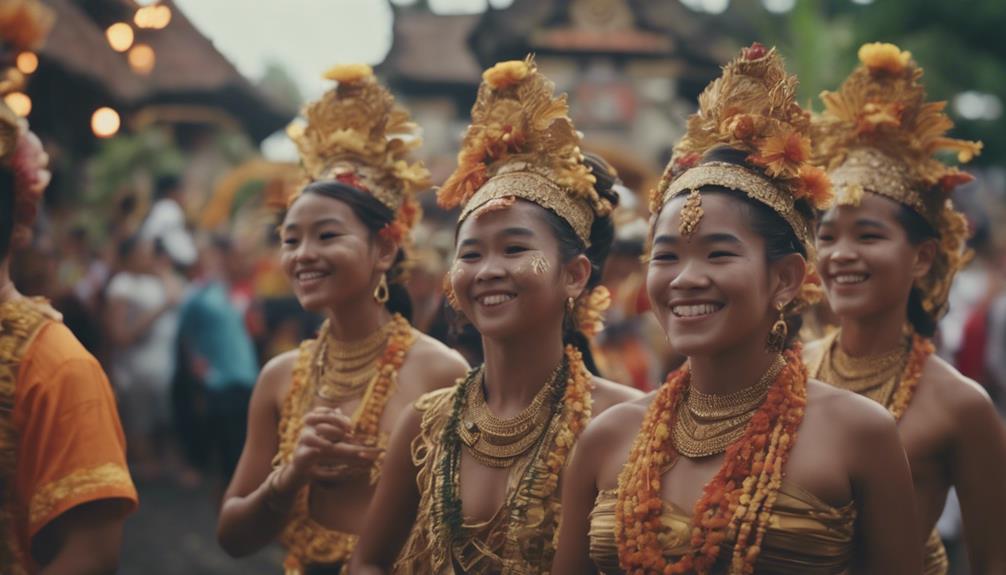
As you immerse yourself in the rich culture of Bali, you'll find that religious festivals and celebrations play a pivotal role in the island's social and spiritual life. Festival participation is a dynamic representation of Bali's unique religious identity, creating an intense, vibrant spectacle that's hard to ignore.
You'll witness locals donning traditional costumes, an essential element that adds depth and color to these celebrations. These costumes, often handcrafted with intricate designs and patterns, are more than just clothing. They're a tangible representation of Bali's rich historical narratives and spiritual beliefs.
Festivals like Galungan, marking the victory of Dharma over Adharma, or Nyepi, the day of silence, provide a fascinating insight into the Balinese perception of the cosmos. These celebrations aren't just about the ceremonies. They're an embodiment of the island's communal spirit, a blend of art, religion, and social interaction.
Innovation seekers will appreciate the creativity in the rituals, the ingenious designs of the costumes, and the innovative ways Balinese integrate their religious practices into everyday life. As you explore further, you'll find that Bali's religious festivals and celebrations are a complex tapestry of culture, history, and spirituality.
Spirituality and Modern-Day Bali
In the midst of Bali's bustling modernity, you'll find a thriving spirituality that profoundly influences the daily lives of the island's residents. This unique blend of Modern Spirituality and Balinese Christianity is a proof of the island's adaptability in a rapidly changing world.
The following elements provide insight into the spiritual landscape of modern-day Bali:
- Interfaith Harmony: Balinese Christianity coexists with Hinduism, Buddhism, and Islam, leading to a unique fusion of rituals and beliefs. This cross-pollination has resulted in a Modern Spirituality that respects and integrates various religious principles.
- Spiritual Tourism: The island's spiritual richness has drawn many visitors seeking solace and enlightenment. Yoga retreats, meditation centers, and healing sanctuaries are flourishing, presenting a modern facet of Bali's spiritual identity.
- Ritualistic Lifestyle: Despite modern influences, Bali retains a deeply ritualistic lifestyle. Daily offerings, temple festivals, and spiritual ceremonies are still integral parts of Balinese life.

